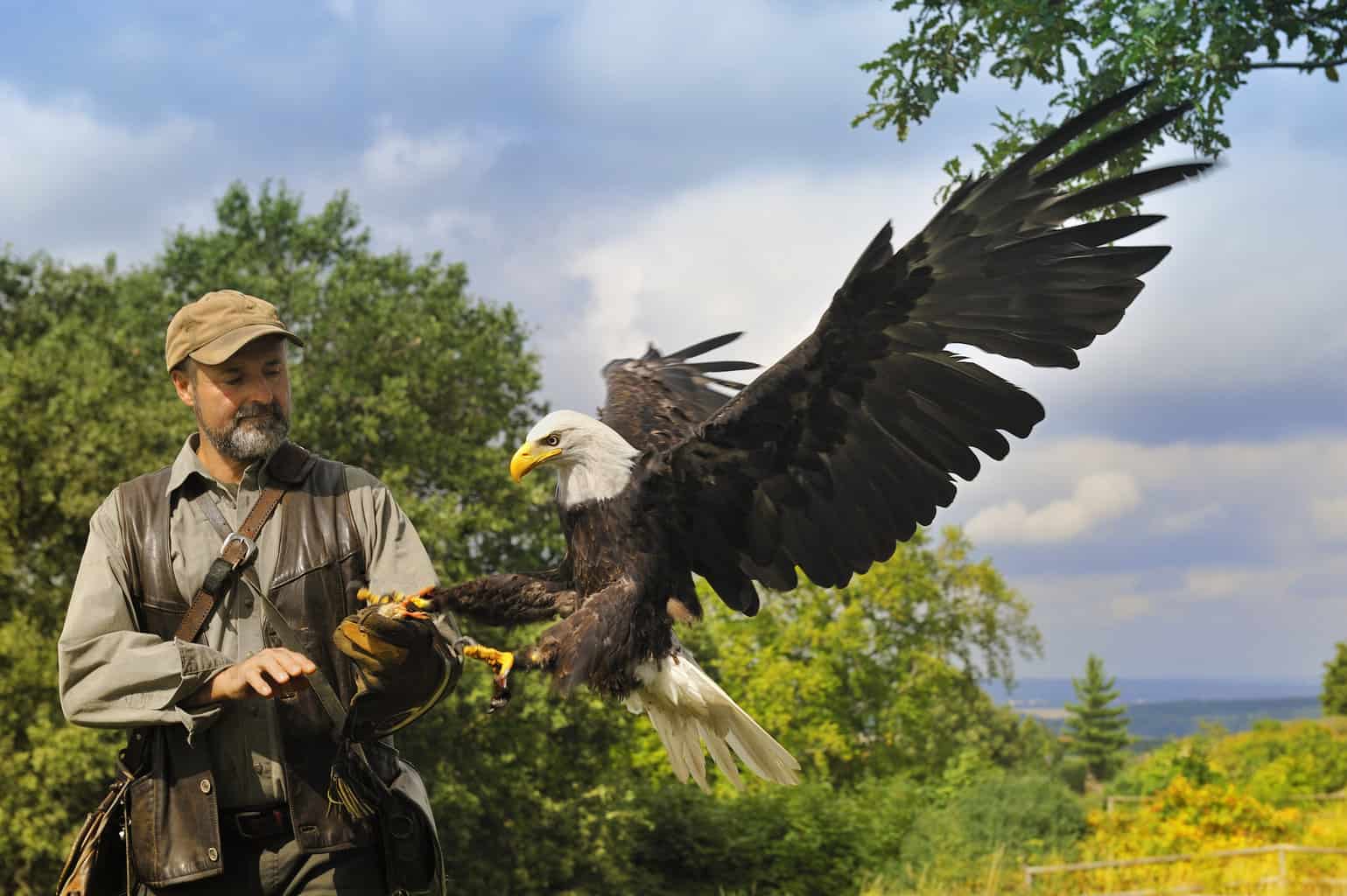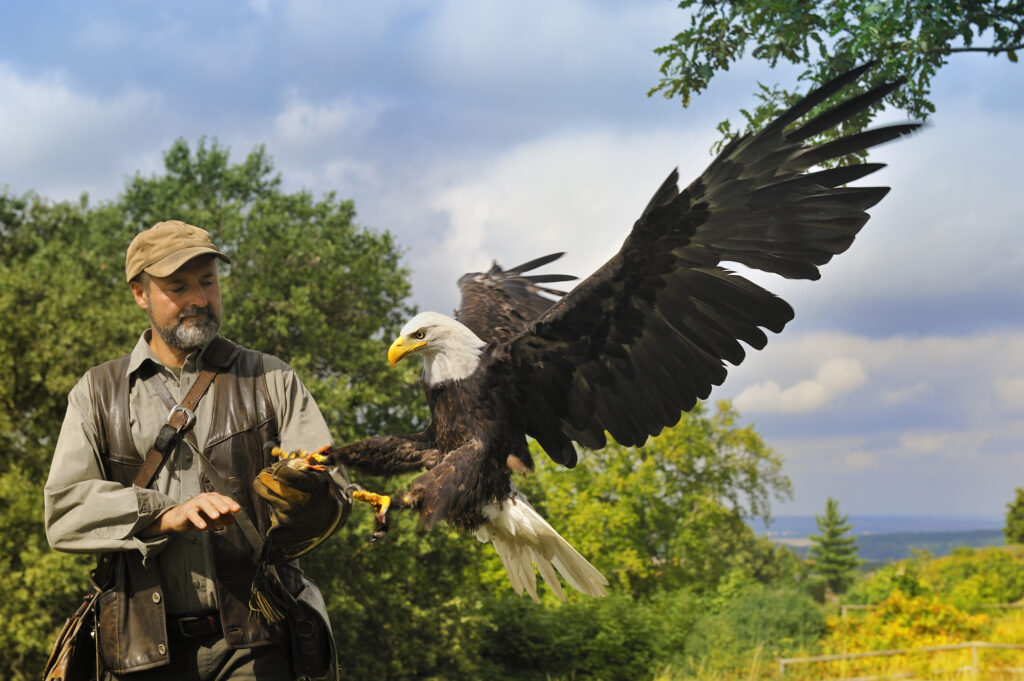American Bald eagles are majestic birds. We know them, of course, as a symbol of the United States. These eagles have the Latin name Haliaeetus leucocephalus.
Soaring above our landscapes, it is not always easy to determine the size of these birds. Many wonder how bald eagles compare to humans in size.
How Big is an American Bald Eagle Compared to a Human?
Eagle vs Human Height and Wingspan
The bald eagle has a body length of 70–102 cm (28–40 in). The body of an eagle is therefore far, far smaller than the body of an average adult human. A bald eagle perched on a branch roughly equals the height of a 2 ½ – 3-year-old child.
However, the typical eagle wingspan is between 1.8 and 2.3 m (5 ft 11in and 7 ft 7in). So the outstretched wings of a fully grown bald eagle are often wider than an adult human is tall.
Eagle vs Human Weight
When it comes to weight, however, the average human far outstrips the bald eagle in size.
The mass of a bald eagle is normally between 3 and 6.3 kg (6.6 and 13.9 lb). The average human newborn is 7lbs 6oz, so within the same range. As you can see, even a very young child is still heavier than a bald eagle at its maximum weight.
Eagle Size Variations
One interesting thing to note about eagles is that the females are about 25% larger than the males. Females average as much as 5.6kg (12 lb), compared to the males’ average weight of 4.1kg (9.0lb). But still, a human will typically reach 12lbs in weight well before they reach 6 months old.
The ranges for the size and weight of bald eagles are relatively wide because these birds differ in size and weight depending on where they are found.
As a general rule, the further birds live from the equator and the tropics, the larger and heavier they are. Size and weight also vary due to a range of factors, such as prey availability.
Could an Eagle Pick Up a Human?
Eagle Strength
Bald eagles are known to fly with fish or other prey at least equalling their weight. Though typically, like all large eagles, they cannot normally take flight carrying prey more than half of their weight unless aided by favorable wind conditions.
So theoretically a bald eagle could carry off a very, very young baby. However, there are absolutely no cases of this occurring.
Eagle Diet
Bald eagles are opportunistic carnivores. This means they will eat a wide range of prey when it presents itself.
Their diet includes fish (which typically makes up over half of their diet), other birds, small mammals, and occasionally other creatures, such as reptiles, amphibians, or invertebrates along coastlines. But they are not known to prey on humans at all.
The fact of the matter is that there is no reason for an eagle to pick up a human, even if they did have the opportunity to do so. Like most creatures, they are more afraid of us than we might be of them.
They typically choose to nest where humans are not and are sensitive to human-made noise, especially during the breeding and nesting season. Though they often live alongside humans, they will tend to be shy and steer clear of humans and human activity where possible.
Is an Eagle Stronger Than a Human?
While an eagle could not lift a human, these birds are remarkably strong.
A bald eagle’s gripping strength is, on average, ten times stronger than the grip of an adult human hand. A bald eagle can exert a force of upwards of 400 pounds per square inch (psi).
Could an Eagle Harm or Kill a Human?

Are Eagles a Threat to Humans?
Beloved by many, some have imagined that these birds pose a threat to humans. In fact, though large and aggressive birds of prey, these birds pose little to no threat to us. Though these birds are relatively big in avian terms, we are far heavier, as mentioned above (and more dangerous as a species).
Though eagles have large talons, and great strength, and could easily do us harm, they simply do not tend to do so. There are no known cases of an eagle killing a human in the United States.
Human predation (even of young children) is thought to be non-existent. Even injury due to a bald eagle is extremely rare, and injuries sustained have not been life-threatening.
Do Eagles Attack Humans?
Eagles will only attack humans encroaching on their space, and only do so when they feel they have no other choice. Very, very rare cases of attack are generally when humans get in the way when the eagles are defending their territory or nests.
Bald eagles specifically are not known to attack humans at any time. Scientists regularly band eaglets, and even when they approach nests, adult birds will not usually attack but will circle and cry loudly instead. So even when humans do approach, attacks are extremely rare, if not non-existent.
Bald eagles want to stay away from humans as much as they can, and will fly from danger rather than attack.
Eagle Attack Myths
Sadly, myths have persisted. There were common beliefs or apocryphal tales in many areas of bald eagles grasping young children and carrying them off.
However, we have historically posed much more of a threat to eagles than they do to us. This is sadly still true today.
Human Threat to Eagles
Illegal Shooting of Eagles
In 1930, a New York ornithologist wrote that in the state of Alaska in the previous 12 years, approximately 70,000 bald eagles had been shot due to alleged (but almost entirely untrue) acts of predation on people, livestock, and pets.
The illegal shooting was the leading cause of death of adult and immature bald eagles in 1978, according to the US Fish and Wildlife Service.
Pesticide-Related Eagle Death
Humans also decimated the bald eagle population in the 20th century through the widespread use of DDT in North America. This pesticide, used in farming and gardening, made the eagles infertile or unable to lay healthy eggs.
Bald eagles were in danger of being wiped out in the late 20th Century, but fortunately, their numbers have greatly recovered (after DDT was banned and the species was protected) and they were removed from the List of Endangered and Threatened Wildlife in the contiguous United States in 2007.
Still, in a study undertaken into bald eagle mortality between 1963 and 1984, 68% of deaths were human-caused. Though eagles are far more protected today, we still pose a threat to bald eagles.
Illegal shooting and lead poisoning (from toxic ammunition) are among the primary threats to bald eagles. Habitat loss, power line electrocution, and wind energy also play a role in eagle deaths. Rodenticides and other harmful chemicals are also killing birds of prey, and all forms of pollution, including noise pollution, can be a major problem.
Eagles: To Be Protected, Not Feared
We are far more likely to cause harm to bald eagles than they are to cause harm to us.
These large and powerful birds should be protected and nurtured, admired, and not feared.
Protection and restoration of bald eagle habitat, modification to power infrastructure and wind turbines, the use of lead-free ammunition, and avoidance of pollutants and pesticide use are all important steps to keep bald eagles safe.
The better we understand these birds and our relations with them, the better equipped we are to avoid any harm and help the continued recovery of this species.

